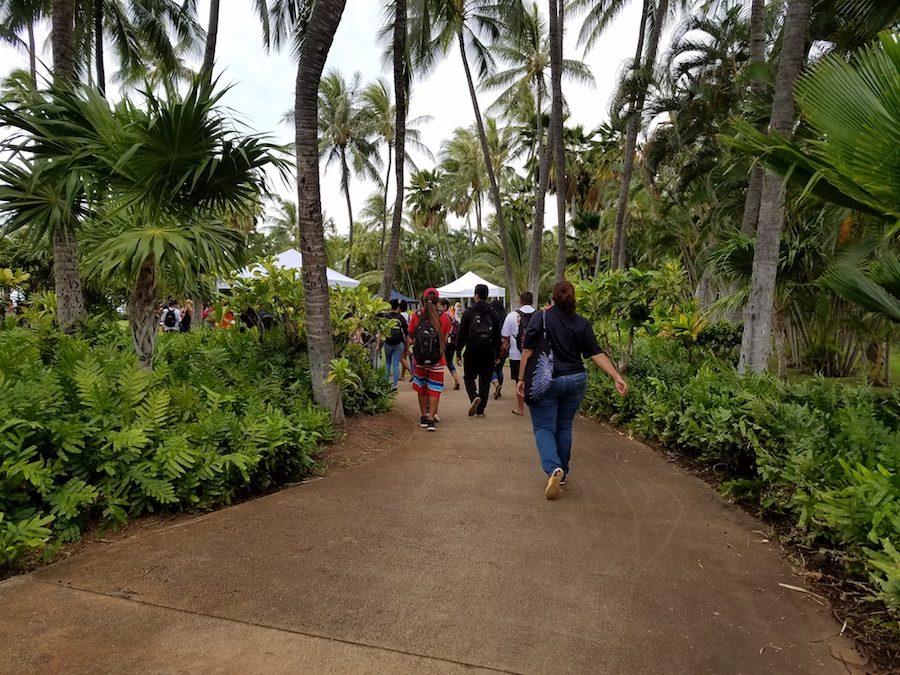The legacy of the lei
On February 24, 2017, the swishing noises of Pa’u (traditional practice attire worn in hula), and distant chanting, resonated from one of the smallest coves in Ko’olina, which marked the 10th annual Lei O Lanikuhonua Hula Festival.
With a wide range of student participants from at least ten different schools, the Lei O Lanikuhonua is a hula festival which provides a unique experience for all of the participants.
There are no winners at this festival, it is simply, Nā Kumu a me nā hāumana, which means the teachers and the students.
By stripping away “competition” and sorting every student into groups based by ability or even at random, the entire day is completely dedicated to perpetuate the culture and the ancient art of Native Hawaiians, which honors the wishes of the James and Abigail Campbell foundation, as well as Princess Abigail Kawananakoa who has sponsored the festival every year.
For this year in particular, there were a total of ten notable Kumu Hula who assisted in the organization and instruction of Lei O Lanikuhonua.
Nanakuli High and Intermediate’s own Michelle Piper who teaches ʻŌlelo Hawaiʻi (Hawaiian Language) said, “It’s especially exciting for me to have 50 students, open to learn ancient hula in different styles and teachings.”
The names of the participating Kumu were:
Kumu Olana Ai
Kumu Coline Aiu
Kumu Kaleikaʻapuni Harmony Brighter
Kumu Leimomi Ho
Kumu Aukele Siangco
Kumu John ʻAiwohi
Kumu Nettie Lapilio
Kumu Noelani Chang
Kumu Twyla Mendez
Kumu Kimo Keaulana
Each Kumu brought their own handpicked numbers and teaching styles to the festival, where they received their students right after the opening ceremony, and taught their groups for nearly four hours.
For NHIS Junior, Mia Ka’aukai, her favorite part was those first two hours of learning the movement and Kaona or the hidden message behind her group’s song which was ‘Maika’i Kaua’i’. “For me it’s more like “It’s in your blood already” so the conference allowed me to connect even further with my cultural identity.”
After the first two hours of learning an entire hula number which connected them on a cultural level. The students, teachers, chaperones and staff took about an hour break for lunch where they sat down and got to know one another better.
As soon as lunch came to end, each of the groups resumed their lessons and began to clean up their numbers in preparation for the main event; Hoʻike, which is a showcase for all of their hard work and dedication.
When asked about his reaction to each of the performances, Kumu Keaulana said “All of the groups did exceptionally well” and further explained “You could see the enjoyment in their faces, the Kumus and the students.”
The numbers or rather mele (hawaiian songs and chants) performed at Hoʻike, spoke of the Hawaiian people, their places, gods, and even a cherished cracked ʻipu heke (gourd percussion instrument) which was known for being “Tubby”.
However, the many light hearted mele being sung and danced that day had a much greater purpose.
And its purpose gave a new sense of purpose according to Kumu Michelle Piper from NHIS, who said this about her students post-conference, “They’ve (NHIS Students) gained more courage to get up on stage and dance, and just embrace their culture.”
The experience of the 10th annual Lei O Lanikuhonua Hula Festival has been to perpetuate the culture and gain further knowledge of its responsibilities.
Nānākuli High and Intermediate School’s own Jewlynn Kirkland, who continues to support the festival yearly, placed it into her own words, “We should exemplify what it means to be Hawaiian; observe, listen, and be respectful.”



